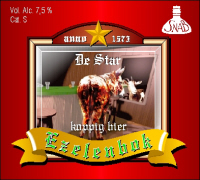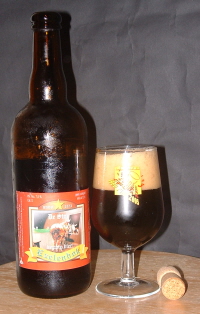First published in BEER December 2005
Origin: Lochristi, East Flanders, Belgium
ABV: 7.5 per cent
 Dutch autumn bokbier must be one of the most underpublicised beer styles outside its home country: world beer surveys often don’t mention it all, or treat it as a footnote to German Bock. Yet it’s really a style in its own right, and in the Netherlands it holds a special place at the heart of the craft beer revival.
Dutch autumn bokbier must be one of the most underpublicised beer styles outside its home country: world beer surveys often don’t mention it all, or treat it as a footnote to German Bock. Yet it’s really a style in its own right, and in the Netherlands it holds a special place at the heart of the craft beer revival.
The annual Bokbierfest at the end of October in Amsterdam is the world’s only major beer festival dedicated to a single style, and attracts thousands from all over the Netherlands and beyond. To coincide with the festival, a series of panel tastings names the tastiest boks, and this year top prize went to Ezelenbok (Donkey’s Bock).
The fact that this beer is not actually brewed in the Netherlands but in Belgium is yet another twist in the intriguing history of a border-crossing style from a small trading nation.
The town of Einbeck in Lower Saxony, Germany, claims credit for inventing Bock, and the local brewery, now part of the vast Radeberger group, still labels its strong beers “Ur-Bock”, original Bock. The word “Einbecker”, so the story goes, got mangled into “Bock” when the style took root in Bavaria. But the fact that the word “Bock” (or “bok” in modern Dutch spelling) means billy goat in both German and Dutch indicates a simpler explanation for the origin of the name.
German Bocks are strong lagers, often pale or amber and associated with the spring season, but Dutch boks are dark winter warmers. They first appeared in the late 19th century, when Dutch commercial brewers were converting to cold fermentation and buying in German kit and expertise, so were originally probably always brewed as lagers.
Prior to 1913, boks appeared in February but the start of the season has since suffered a century of anticipation creep, slipping back past Christmas to the beginning of October by 1950. This year it was moved still earlier to 21 September which, given the warm weather, has resulted in the unlikely sight of drinkers enjoying a bok while basking in the sun on café terraces.
By the early 1980s, bok was one of the only alternatives to the ubiquitous “pils” churned out by Heineken and its competitors, and was itself coming under threat. Resistance arrived in the form of PINT, the Dutch beer consumers’ organisation which celebrated its silver anniversary this year. Bokbier was PINT’s early cause célèbre and the annual festival, originally started by a pioneering speciality beer pub, became a flagship event.
The revived interest in speciality beer spearheaded by PINT led to a new wave of Dutch microbrewers. Since most of these were equipped for ale rather than lager production, a new style of warm-fermented bok emerged, often unfiltered and unpasteurised. This development has offered a rare opportunity to compare both ale and lager interpretations of the same basic style side to side.
Today’s bokbiers offer a surprisingly wide range of flavours united by a few key themes. All the beers are dark (ruby red or brown, though some brewers now offer a paler spring variant), strong (the classic gravity is 6.5 per cent but some go up to 8 or 9) and malt-accented. Balancing bitterness comes more from roasted grain than hops.
Broadly, the lager versions are smoother, more consistent and more reliable, while the ales are fruitier, often more complex, and sadly more hit-and-miss in terms of consistency and quality.

Proef SNAB Ezelenbok
Ezelenbok is a bottle- and cask-conditioned ale-style bok that can’t be faulted for quality, perhaps because it emerges not from a tiny Dutch micro but from Belgium’s Proef brewery, where they specialise in brewing small batches under contract. It’s commissioned by SNAB (The North Holland Alternative Brewers’ Society), who also devise and market several other excellent specialities.
Such “brewers without breweries” are more common in countries like the Netherlands and although the arrangement might provoke suspicion from British drinkers, SNAB are honest and transparent about it, with the brewery of origin clearly stated on the label as well as a full ingredients list: Munich, crystal, pilsener and chocolate malts, and Hallertau Hersbrücker hops.
The beer itself is a superb and very refined example of an ale-type. It’s a very dark burgundy (80 EBC) with a thick foamy fawn head and a candyish malty aroma with herbal, blackcurrant and liquorice traces.
A smooth, malty and very nutty palate yields a sweetness balanced by good roasty notes and burry hops (32 EBU), leading to a long dry slightly herbal finish softened by light fruity syrup. The brewer advises up to one year maturing in bottle but it could probably develop for a longer period.
Unfortunately, I’ve never seen a Dutch bok on sale in Britain, but if you’re in Amsterdam over the next couple of months you’ll find a great selection of bottled boks at the Bierkoning beer shop just round the corner from Damplein (Paleisstraat 125, tel +31 (0)20 625 2336, www.bierkoning.nl ). Comparing Ezelenbok with one of the better lager styles like Amstel or Brand is a good place to start exploring this intriguing seasonal style.
Read more about this beer at ratebeer.com: http://www.ratebeer.com/beer/snab-ezelenbok/18134/





Leave a Reply